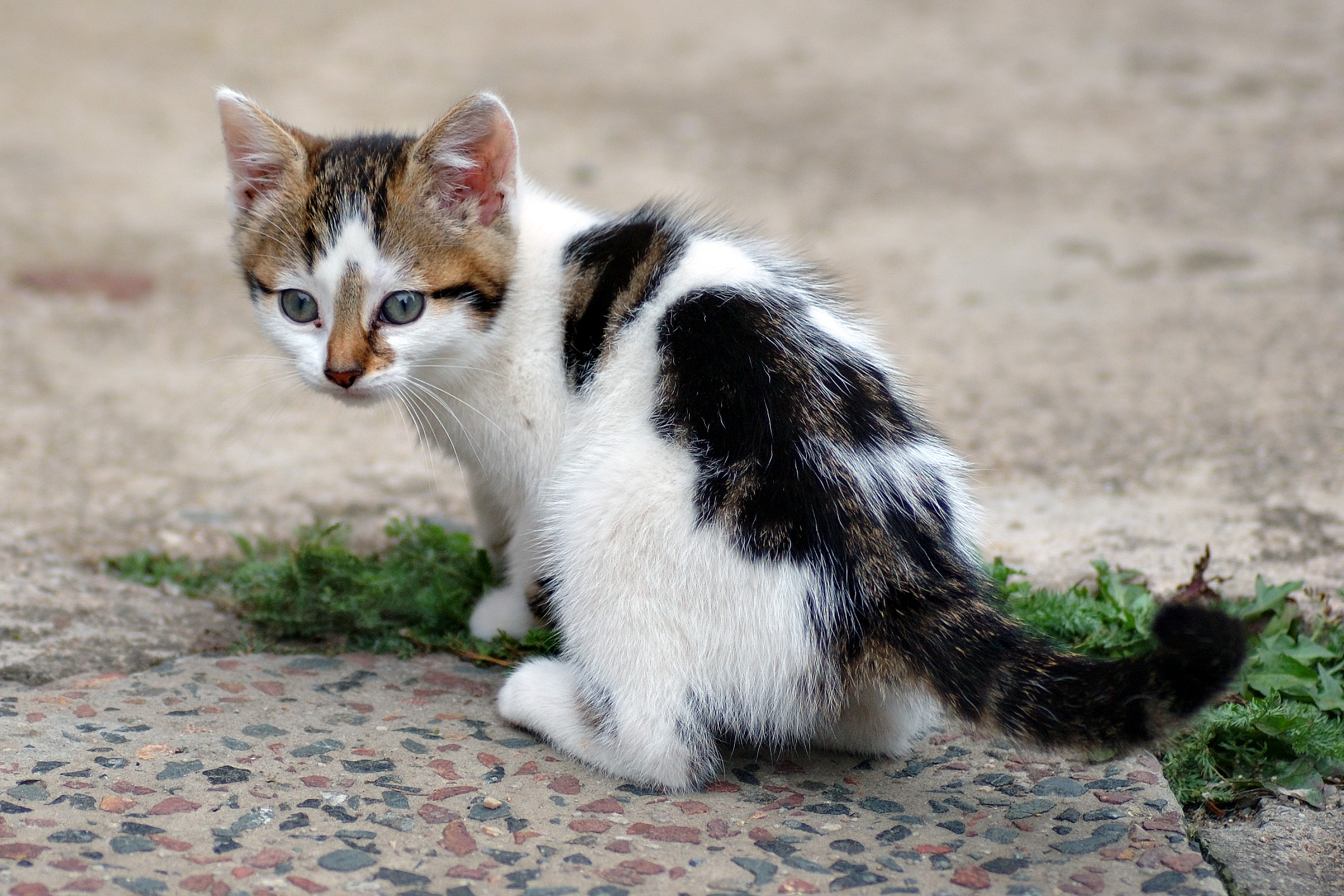Best Rabbit Cage 2025
Top Rabbit Cages for Indoor and Outdoor Housing
Proper rabbit housing directly impacts your pet's physical health, mental wellbeing, and lifespan. According to the House Rabbit Society, rabbits require significantly more space than most commercial cages provide, with specific flooring, ventilation, and safety requirements often overlooked in product marketing.
Unlike dogs or cats, rabbits spend extensive time in their primary living space, making cage selection a critical decision that affects daily quality of life for potentially 8-12 years.
Complete Rabbit Cage Buying Guide
Critical Space Requirements That Most Cages Ignore
The House Rabbit Society recommends minimum enclosure sizes significantly larger than most commercial "rabbit cages" provide. These guidelines reflect research on rabbit behavior, exercise needs, and psychological wellbeing.
Minimum Dimensions by Rabbit Weight
Small Breeds (2-4 lbs): Minimum 36" x 24" x 18" high. Netherland Dwarfs and similar breeds need space to hop, stretch, and exhibit natural behaviors despite their compact size.
Medium Breeds (4-8 lbs): Minimum 48" x 24" x 20" high. Holland Lops, Mini Rex, and similar breeds require additional length for comfortable movement and exercise.
Large Breeds (8-12 lbs): Minimum 60" x 36" x 24" high. Flemish Giants, New Zealand Whites, and other large breeds need substantial space for physical and mental health.
Exercise Time Requirements
Even appropriately-sized cages require daily exercise time outside the enclosure. Rabbits need 3-4 hours of supervised activity in a larger space for optimal physical and mental health.
Flooring Safety: Protecting Rabbit Feet and Joints
Rabbit feet lack protective pads like cats and dogs, making them vulnerable to pressure sores and joint problems from inappropriate flooring. Wire flooring, still common in many commercial cages, creates serious health risks.
Safe Flooring Options
Solid plastic flooring with textured surfaces provides the safest option for daily use. The texture prevents slipping while protecting feet from pressure points.
Combination systems using solid platforms over wire sections allow waste to fall through while providing comfortable resting areas. At least 75% of floor space should be solid surfaces.
Wire spacing specifications matter when wire sections are included. Gaps wider than 1/2 inch can trap rabbit feet, causing injury or panic responses.
Bedding and Substrate
Appropriate bedding over solid flooring improves comfort and absorption. Paper-based bedding, hay, or specialized rabbit bedding provide safe options. Avoid cedar or pine shavings, which contain aromatic oils that can irritate rabbit respiratory systems.
Ventilation Design and Wire Spacing Standards
Proper ventilation prevents respiratory problems while maintaining temperature control. Rabbit respiratory systems are sensitive to ammonia buildup from urine, making air circulation essential.
Wire Gauge and Spacing Requirements
14-gauge wire minimum provides structural integrity while allowing adequate airflow. Thinner wire can bend under rabbit weight or chewing pressure.
1/2 inch x 1 inch wire spacing on sides and top prevents escape while ensuring ventilation. Smaller spacing restricts airflow; larger spacing allows small rabbits to squeeze through.
Powder coating over galvanization provides chew-resistant surfaces that don't chip or flake. Raw galvanized wire can contain zinc levels harmful to rabbits if consumed through chewing.
Product Comparison: Space and Features
| Product | Dimensions (L×W×H) | Floor Type | Levels | Max Rabbit Weight | Price Range |
|---|---|---|---|---|---|
| Living World Deluxe | 47" × 24" × 24" | Solid plastic | 2 | 8 lbs | $180-220 |
| MidWest Wabbitat | 47" × 24" × 20" | Solid plastic | 1 | 10 lbs | $120-150 |
| Prevue Multi-Level | 42" × 18" × 37" | Wire with platforms | 3 | 6 lbs | $160-190 |
| AmazonBasics | 36" × 19" × 17" | Wire with tray | 1 | 5 lbs | $60-80 |
| PawHut Hutch | 48" × 20" × 33" | Wire with shelter | 2 | 8 lbs | $200-250 |
Top 5 Rabbit Cages for Different Needs
1. Living World Deluxe Habitat - Best Overall Design
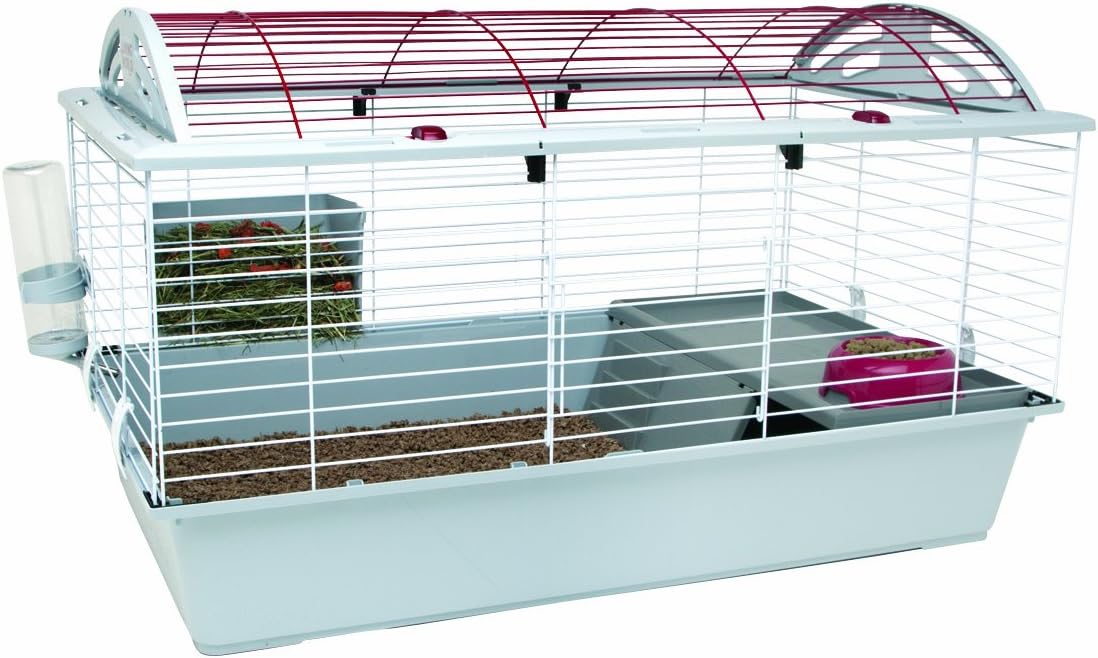
This two-level habitat provides 47 inches of length with solid plastic flooring throughout. The upper level includes a ramp and platform, effectively doubling usable space while maintaining safety and comfort.
Pros
- Solid plastic flooring protects rabbit feet
- Two-level design maximizes space
- Deep base contains bedding effectively
- Easy-access front and top doors
- Includes water bottle and food dish
Cons
- Higher price point than single-level cages
- Ramp may require training for some rabbits
- Assembly requires 1-2 hours
- Limited height for very large breeds
Best For: Medium-sized rabbits needing maximum space in compact footprint.
Check Current Price on Amazon2. MidWest Wabbitat Folding - Best Large Single Level

At 47 inches long, this single-level cage provides generous floor space for larger rabbits. The folding design enables storage when not in use, while the solid plastic base ensures foot safety.
Pros
- Extra-large 47" length accommodates big rabbits
- Solid plastic flooring throughout
- Folds flat for storage or transport
- Includes divider panel for multiple rabbits
- Good value for size provided
Cons
- Single level limits vertical space usage
- Large footprint requires significant floor space
- No included accessories
- Wire spacing may be wide for small rabbits
Best For: Large breed rabbits or owners needing portable housing options.
Check Current Price on Amazon3. Prevue Pet Multi-Level - Best Vertical Space
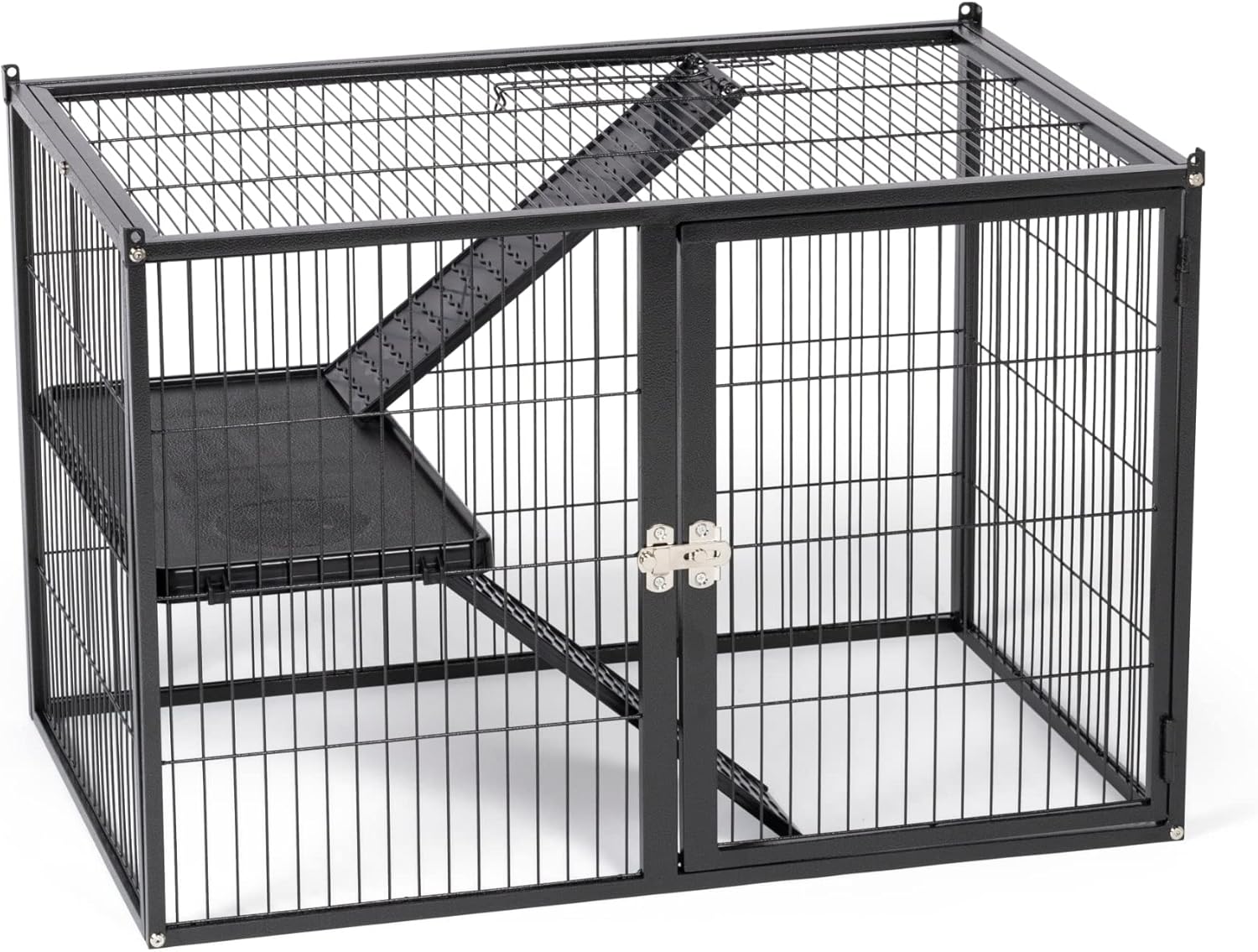
Three levels connected by ramps provide maximum space utilization in a compact footprint. Each level includes solid platform areas while maintaining wire construction for easy cleaning.
Pros
- Three levels maximize vertical space
- Multiple ramps encourage exercise
- Solid platforms on each level
- Good for small to medium rabbits
- Easy access doors on each level
Cons
- Wire flooring requires additional protection
- Not suitable for elderly or disabled rabbits
- Complex assembly with multiple components
- May tip if not properly secured
Best For: Active small to medium rabbits in apartments or limited space situations.
Check Current Price on Amazon4. AmazonBasics Small Animal Cage - Best Budget Option
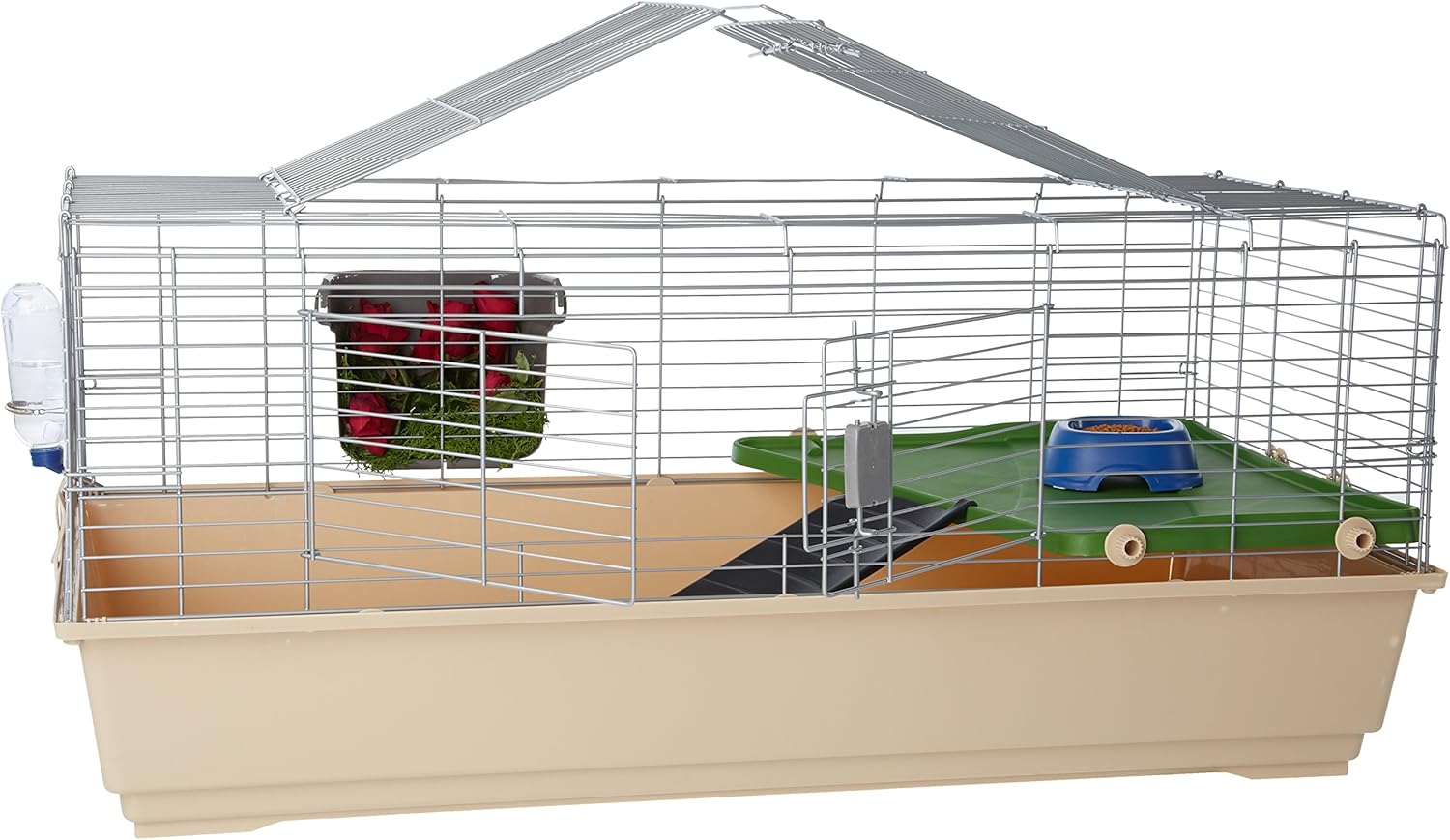
Basic wire construction with plastic base tray provides minimum acceptable space for small rabbits at an affordable price. Suitable for temporary housing or budget-conscious owners.
Pros
- Most affordable option
- Simple assembly process
- Adequate for very small breeds
- Lightweight for moving
- Removable tray for easy cleaning
Cons
- Wire flooring requires protection
- Minimum size for most rabbits
- No included accessories
- Limited long-term durability
Best For: Very small rabbits, temporary housing, or severe budget constraints.
Check Current Price on Amazon5. PawHut Rabbit Hutch - Best Outdoor Option
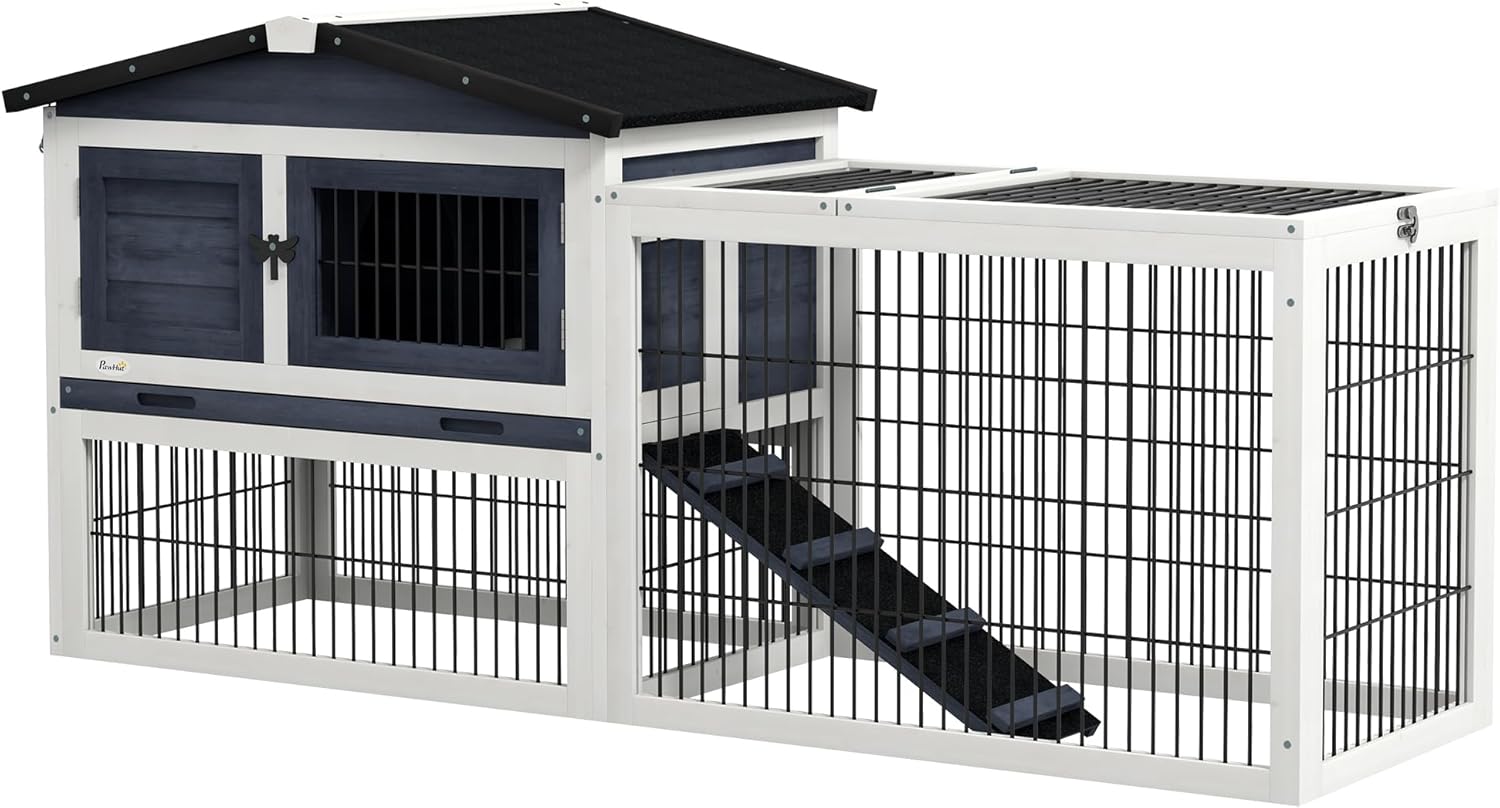
Designed specifically for outdoor use, this hutch features weather-resistant construction and proper ventilation. The elevated design with enclosed shelter area provides protection from elements and predators.
Pros
- Weather-resistant wood construction
- Elevated design prevents ground moisture
- Enclosed shelter with open run area
- Asphalt roof for weather protection
- Easy-access doors for maintenance
Cons
- Requires outdoor space and setup
- Wood requires periodic maintenance
- Assembly requires tools and time
- May need additional predator-proofing
Best For: Rabbits housed outdoors with proper climate considerations and adequate yard space.
Check Current Price on AmazonIndoor vs Outdoor Housing Considerations
Housing location significantly affects cage requirements, safety considerations, and long-term costs. Both options have advantages and challenges that impact product selection.
Indoor Housing Benefits
Indoor rabbits enjoy climate control, predator protection, and closer interaction with family members. Temperature stability reduces stress and health complications while enabling year-round comfortable conditions.
Indoor cages require less weather-resistant construction, allowing for lighter materials and more design options. Cleaning and maintenance are easier with convenient access to utilities and supplies.
Outdoor Housing Challenges
Outdoor rabbits face temperature extremes, predator threats, and weather exposure that indoor rabbits avoid. However, outdoor housing can provide more space and natural environment enrichment when properly designed.
Predator-proofing requires specific construction features including buried wire mesh, secure latching systems, and elevated designs that prevent digging access.
Frequently Asked Questions About Rabbit Cages
Bonded rabbit pairs need approximately 50% more space than single rabbits. A minimum of 60" x 36" floor space works for medium-sized pairs, with additional vertical space or exercise time compensating for smaller cages.
Dog crates can work temporarily but lack rabbit-specific features like appropriate wire spacing, solid flooring, and ventilation design. The bar spacing is often too wide for rabbit safety, and the flooring may not protect rabbit feet adequately.
Bedding provides comfort and absorption over solid flooring. Paper-based bedding, hay, or specialized rabbit bedding work well. Avoid aromatic wood shavings (cedar, pine) that can irritate rabbit respiratory systems.
Spot-clean daily by removing soiled bedding and uneaten fresh foods. Complete cage cleaning with disinfection should occur weekly, or more frequently if odors develop or multiple rabbits share the space.
Essential accessories include water bottle or bowl, food dish, hay rack, litter box for litter-trained rabbits, and hiding spots for security. Toys and chew items provide enrichment and prevent destructive behaviors.
Affiliate Disclosure: ThePetProductLab participates in affiliate programs including Amazon Associates. We may earn commissions on qualifying purchases made through our links at no extra cost to you.

